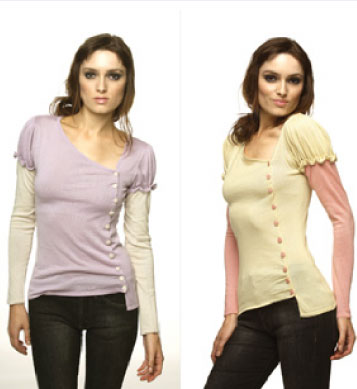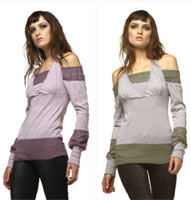Category: Winter 2006/2007
Xtreme Lashes™ – Made for the Low Maintenance Beauty Junkie
The Beauty Agenda
Xtreme Lashes™ – Made for the Low Maintenance Beauty Junkie
As I lay on the table in the stark white room, the skillful technician placed one eyelash at a time on my lids. I closed my eyes and imagined just how lovely I would be in the tropical islands that I would be visiting on my trip to the Caribbean. Some people thought that what I was doing was indulgent, but I saw it as self-preservation. After all, I wouldn’t have the time to apply false eyelashes after a long day’s excursion in Key West, Cozumel, or the Caymen Islands. I had to look glamorous. Why? Because I was on a cruise! I had to dress up for dinner and be elegant for at least half of my meals.
You might think that spending $250.00 for eyelash extensions is extravagant. But it really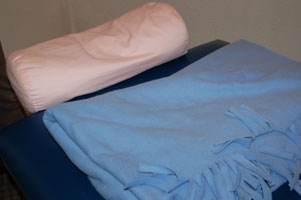 paid off big when I received compliment after compliment, and stare after stare. A couple of people even commented on how gorgeous my eyes were. I am not an unattractive female, but never before have I received so many comments directed at my eyes. What made the eyelash extensions so wonderful was the fact that I could go scuba diving, disco dancing, jet skiing, and sunbathing, and never once did I have to worry about my eyelashes. My makeup might have worn off a time or two, but my eyelashes lasted the entire trip. The only problem I encountered was the extreme humidity of the Caribbean. Instead of my lashes lasting two months, they only lasted three weeks. They started to fall off shortly after I returned home from my vacation.
paid off big when I received compliment after compliment, and stare after stare. A couple of people even commented on how gorgeous my eyes were. I am not an unattractive female, but never before have I received so many comments directed at my eyes. What made the eyelash extensions so wonderful was the fact that I could go scuba diving, disco dancing, jet skiing, and sunbathing, and never once did I have to worry about my eyelashes. My makeup might have worn off a time or two, but my eyelashes lasted the entire trip. The only problem I encountered was the extreme humidity of the Caribbean. Instead of my lashes lasting two months, they only lasted three weeks. They started to fall off shortly after I returned home from my vacation.
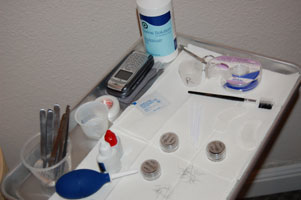 Xtreme Lashes™ is the product that I used. This was an experiment to see if I could go without those cumbersome false eyelashes and enjoy the freedom of “naturally” long eyelashes.
Xtreme Lashes™ is the product that I used. This was an experiment to see if I could go without those cumbersome false eyelashes and enjoy the freedom of “naturally” long eyelashes.
Xtreme Lashes™ is a relatively new product that lengthens and thickens eyelashes. They are semi-permanent eyelash extensions that are individual synthetic lashes designed to replicate a natural eyelash, and are applied one eyelash extension at a time. They not only extend the length of your original eyelashes, but they also thicken at the same time.
To apply one set of eyelash extensions, the procedure takes anywhere from 90 to 150 minutes. When I got my eyelashes extended, I was comfortable—I had my iPod for entertainment, and it was over before I knew it. Touch-ups can be done in as little as 15-45 minutes.
Xtreme Lashes™ uses HP-3 high performance bonding agents. It has all the key features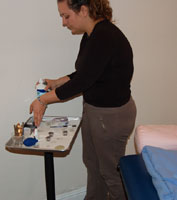 needed in superior eyelash extension glue. It is odorless and bonds stronger, dries faster and lasts longer. The primary agent of HP-3 is the same substance used for closing wounds without stitches. And to remove these lashes, you use the Xtreme Lashes™ Specialty Formulated Bonding Agent Remover. This is a gentle remover that quickly and gently removes the bonding agent without harming your natural eyelashes. It is a medical grade that smells great and contains antibiotic agents.
needed in superior eyelash extension glue. It is odorless and bonds stronger, dries faster and lasts longer. The primary agent of HP-3 is the same substance used for closing wounds without stitches. And to remove these lashes, you use the Xtreme Lashes™ Specialty Formulated Bonding Agent Remover. This is a gentle remover that quickly and gently removes the bonding agent without harming your natural eyelashes. It is a medical grade that smells great and contains antibiotic agents.
 If you are not into high maintenance, then eyelash extensions could be the answer. I highly recommend this product for brides. Imagine looking gorgeous with your semi-permanent lashes. And after you remove the elegant bridal makeup and gown after your special day, you still have those long luscious lashes. And when you board that plane, that ship, or that bus for your romantic honeymoon, you will be the envy of all women. No matter how extreme the temperature, your lashes will last. I don’t know about you, but I am one of those people whose eyes seem to disappear when they’re not wearing any eye makeup. Xtreme Lashes™ takes care of that problem completely.
If you are not into high maintenance, then eyelash extensions could be the answer. I highly recommend this product for brides. Imagine looking gorgeous with your semi-permanent lashes. And after you remove the elegant bridal makeup and gown after your special day, you still have those long luscious lashes. And when you board that plane, that ship, or that bus for your romantic honeymoon, you will be the envy of all women. No matter how extreme the temperature, your lashes will last. I don’t know about you, but I am one of those people whose eyes seem to disappear when they’re not wearing any eye makeup. Xtreme Lashes™ takes care of that problem completely.
I know this is starting to sound like an advertisement, and I am by no means being paid to endorse this product, but I can assure you, it is worth every dollar. Try it once, and you will be amazed. You just might get hooked as I did.
Xtreme Lashes™ has been featured in Redbook, Hairstyles, Hairdo Ideas, Spa Review, Inside Edition, Jane, Teen Vogue, OK Weekly; and has been worn by celebrities Diedre Hall, Bai Ling, Regina King, Cathy Hickland, Shannon Doherty, Miss Texas 2007, and Allison Janney.
To learn more about Xtreme Lashes, or to set an appointment for eyelash extensions, visit their website at www.xtremelashes.com.
Written by Kaylene Peoples
The Good Eater – Author Ron Saxen
The Good Eater
Ron Saxen
 The Good Eater by Ron Saxen, due to be published in March, is the true story of a male model’s struggle with binge eating. This is a problem more common among women, but this young man at a very early age found solace from his problems by eating, and as a result, always struggled with a weight problem.
The Good Eater by Ron Saxen, due to be published in March, is the true story of a male model’s struggle with binge eating. This is a problem more common among women, but this young man at a very early age found solace from his problems by eating, and as a result, always struggled with a weight problem.
Ron’s binge-eating roots, like most people with emotional problems, lay in his past. He was the third child of a very strict, tyrannical father and a mother who was a religious fanatic. He had two older brothers and two younger sisters.
His binge eating started at thirteen years old, when waiting for his father to come home and punish him for the wrongs of the day his mother had written down in her notebook, he began to eat the chocolate from the school sales he had stored in his closet. And he felt better immediately! From then on, to placate himself, he ate. Food gave him pleasure. He had learned that anything he could do to please his parents and maintain the “fragile” peace was a good thing. Winning food contests at the dinner table—finishing before everyone else—was one of those things that pleased his father and kept the peace, staving off the punishments and whippings. And he loved food!
At sixteen, his father left home; and since his two older brothers had moved out, he became the man of the house. He went on his first diet; but since his answer to every problem was eating, of course, he always returned to eating for comfort. He became obese, and for the next years struggled with his weight.
However, Ron was very good looking, and in 1984, at the low end of his yo-yo dieting (260-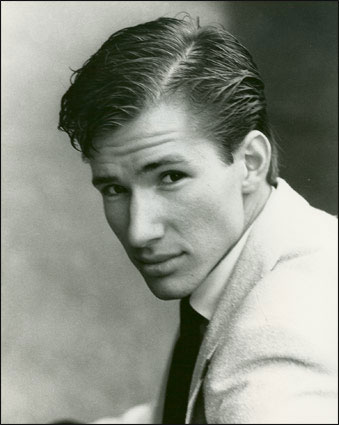 225), he was asked a number of times if he was a model. He was twenty-one years old. Encouraged to try modeling, he lost enough weight to qualify as a model. He tried out and was very successful, until confronted with a problem and returned to binge eating to solve it, or at least to make himself feel better. He put the weight on again and gave up modeling. He tried being a comedian, writing acts and performing them on stage. Eventually, failing at that, having now received his college degree, he tried the Marine Corps’ Officers Candidacy School. He hoped that being a Marine would magically erase his past and solve all of his problems. When this failed, he tried selling insurance, then using drugs . . .one attempt after another to control his eating and thus his weight.
225), he was asked a number of times if he was a model. He was twenty-one years old. Encouraged to try modeling, he lost enough weight to qualify as a model. He tried out and was very successful, until confronted with a problem and returned to binge eating to solve it, or at least to make himself feel better. He put the weight on again and gave up modeling. He tried being a comedian, writing acts and performing them on stage. Eventually, failing at that, having now received his college degree, he tried the Marine Corps’ Officers Candidacy School. He hoped that being a Marine would magically erase his past and solve all of his problems. When this failed, he tried selling insurance, then using drugs . . .one attempt after another to control his eating and thus his weight.
See how, with some lifestyle changes and the help of friends, Ron finally, years later, gets his eating under control, and as a result, his life. This memoir, at times light and funny, at others dark and sad, reads like a novel, with a plot whose conflict I kept wanting to be resolved happily for Ron so that he could stop bingeing and keep his weight under control in order to get back to his modeling. You, too, will find it interesting and moving.
The following is from the National Institute of Diabetes and Digestive and Kidney Diseases (http://www.athealth.com/Consumer/disorders/Bingeeating.html):
Although it has only recently been recognized as a distinct condition, binge eating disorder is probably the most common eating disorder. Most people with binge eating disorder are obese (more than 20 percent above a healthy body weight), but normal-weight people also can be affected. Binge eating disorder probably affects 2 percent of all adults, or about 1 million to 2 million Americans. Among mildly obese people in self-help or commercial weight loss programs, 10 to 15 percent have binge eating disorder. The disorder is even more common in those with severe obesity.
Binge eating disorder is slightly more common in women, with three women affected for every two men. The disorder affects blacks as often as whites; its frequency in other ethnic groups is not yet known. Obese people with binge eating disorder often became overweight at a younger age than those without the disorder. They also may have more frequent episodes of losing and regaining weight (yo-yo dieting).
If you think you might have a problem with BED, there are many programs to help you. You can find help first by simply doing a search on the Internet to learn just how serious is your eating problem and get help early, unlike Ron, who took twenty-one years of trying to solve his own problem alone before he got help. Recognizing he had a serious problem, as he tried one thing after another only to fail again, I kept screaming at him: Get some professional help!
You may visit Ron Saxen online at www.ronsaxen.com.
Reviewed by Lee L. Peoples
Dreams
Insights
Dreams
 I’ve spent a fair amount of my adult life in serving others. I helped initiate three of my children into adulthood and single-handedly provided them the support they needed to launch out on their own and start to accomplish things and discover their dreams. While doing this, I put many of my own dreams aside and fell full into serving society, family, and others. That singer and dancer stood in the wings waiting for her turn to perform. In light of life’s little dramas, getting the kids off to school, helping them graduate from high school, and preparing them for college, the performance had to be placed on hold; and the artist writer stood, pen suspended in air, for her time to create.
I’ve spent a fair amount of my adult life in serving others. I helped initiate three of my children into adulthood and single-handedly provided them the support they needed to launch out on their own and start to accomplish things and discover their dreams. While doing this, I put many of my own dreams aside and fell full into serving society, family, and others. That singer and dancer stood in the wings waiting for her turn to perform. In light of life’s little dramas, getting the kids off to school, helping them graduate from high school, and preparing them for college, the performance had to be placed on hold; and the artist writer stood, pen suspended in air, for her time to create.
In the meantime, the world has continued at its pace, and like the raisin in the sun, the dreamer’s dreams seemed to shrivel. All the while the singer and dancer ached to escape the mind’s barriers and make the appearance now.
I am that artist, that dancer, that singer, and that writer.
One day I realized that another moment waiting to find my passion was a moment ill spent. I got in my car and drove cross-country. I drove from Florida to California with only a few of my belongings.
I decided to materialize my dreams out of what seemed to be nothing, and I must say that I am starting to see them become reality.
It takes courage to make changes. It takes the type of courage that causes you to go against tradition to follow your dreams. I should have laid mine down a long time ago to be replaced by responsibility. Working and making a living took precedence for many years, but did not lend me happiness.
I have a friend who emigrated here from India. His long dream to be an actor has finally taken hold in America. He had to make many sacrifices and practice a kind of selfish virtue in order to start to see his dreams materialize. He left family and friends. He set out on the impossible task of learning the acting craft and then someday performing.
“Pressure, I know pressure,” he says. “Pressure to do what your family wants, pressure to do what is right, pressure to make it in a world where you often feel unwelcome.”
In spite of all the pressure, however, he still makes time to take acting classes where he has to let down defenses that were ingrained in him from his youth, taught never to disagree or argue. Taught to be nice always. He is now letting those barriers down to allow opportunity in. He has to pause and ask, “What is it that I truly feel?” In recognizing his true feelings, he can perform and become himself in any character.
I face a similar challenge. I’ve spent a few years caring for others, putting my dreams and myself last. Now I have more freedom. With that freedom I am faced with what do I do now? For so many years all I wanted was the opportunity to do what it was I truly desired: sing, write music, and learn to play the guitar. I’ve been conditioned to seek out something useful to do to ensure that others are cared for. I now am faced with the task of countering that conditioning and discovering what it is that makes me feel fulfilled and truly happy.
Lately I’ve been leaning toward learning the guitar, taking time to dance, and making room for an ever-expanding spiritual side that has lately grown beyond my ability to contain it.
What happens to a dream deferred? In my case, as Langston Hughes so eloquently states, it explodes!
Once your dreams are allowed to spill over, there’s no knowing where they will lead you. In my case they’ve led me to California, three thousand miles from where I started.
Written by Lisa Trimarchi
My First Photo Shoot
Talking Chic
My First Photo Shoot
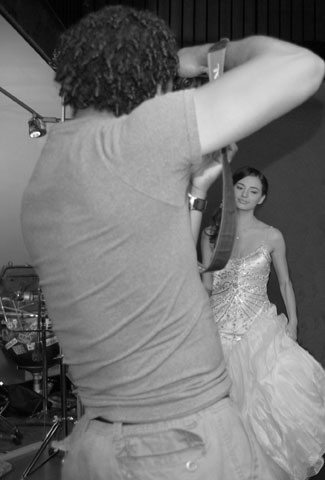 I’m not sure exactly what turned me on to a day of outdoor modeling. Maybe I was tired of hiding behind the computer. Maybe it was to prove my sister right—that I really am the “cool auntie” my niece would grow to love. Maybe it was to explore a new art concentration. Or maybe, as an avid “America’s Next Top Model” viewer, I just wanted to see what all the hype was about… was it really that difficult ?
I’m not sure exactly what turned me on to a day of outdoor modeling. Maybe I was tired of hiding behind the computer. Maybe it was to prove my sister right—that I really am the “cool auntie” my niece would grow to love. Maybe it was to explore a new art concentration. Or maybe, as an avid “America’s Next Top Model” viewer, I just wanted to see what all the hype was about… was it really that difficult ?
One word: YES.
Truth is, out of about 80 photos, only 20 were to my liking. Whether I got my money’s worth, whether I didn’t, whether I ever actually use the shots for anything worthwhile, or whether I hold onto them for my trips-down-memory-lane at 90-years-old, I learned more than I can really say.
To sum it up though, my experience in exploring this thing that we all know as modeling is something no lady of fashion can ever truly understand, or judge for that matter, unless she throws herself into the shoes of a model, especially if you think you can look even more fierce than winner Caridee in a single shot. (Yeah, good luck with that!)
So just do it—let go of all your inhibitions, choose a photographer you are comfortable acting a fool in front of, and realize that you are also choosing to do more than just model.
Because modeling involves much more than just “posing” for the camera, here are a few tips to amateurs who are yet to afford the luxury of hiring your own help or have yet to reach the status to be hired on yourself:
- You have no assistant; eat something first! O. K., so the morning arrives and you decide that the only hard-core way to feel like a model is to skip breakfast and feel skinnier that morning. But guess what? Smack in the middle of working, you feel panicky because you ALSO forget your morning coffee. So in wardrobe (stiletto boots and all), you run into a local Starbucks for a quick java, all the while feeling ridiculous for being dressed totally inappropriate for a college-town coffeeshop.
- Sorry, honey, no makeup artist for you this time! Ain’t that the truth. You love the job you did on your face with your new M.A.C. makeup, and you remember to bring nearly all of it to location. However, because you want to feel free in front of the camera, you leave EVERYTHING in the car. So as you go back and forth to touch up your lips and quickly combat T-zone shininess with powder, you are taking up too much time and losing all concentration because you are focusing too much on the outer beauty versus letting your inner beauty come through.
- Without a publicist, you gotta make your own calls! So if you are serious about taking good photos and you happen to have an awesome photographer who says she will shoot as long as you have the time…don’t screw it up by cutting it short because you were supposed to meet a girlfriend for lunch. Do yourself a favor and keep the day as open as possible for your first day of modeling. And honestly, you will need about an hour to relax, EAT, and calm down from the excitement and stress that made your Saturday an unforgettable December 16th. Without someone next to you who can make that cancellation call for you, this means interrupting the shoot again to go find your cell and become an annoyance to both your friend as well as the photographer.
… And so many more lessons learned from this experience. As a writer who understands the loneliness behind a creative profession, I actually got a taste of the solitude a model probably lives through in order to play dress up and fully transform into that character, allowing herself to become vulnerable and weak in front of the camera. All this while trying to create a masterpiece of raw emotion—whatever that emotion may be.
Overall, it was an indescribable feeling, seeing myself in my favorite pieces (Fortunately, I DIDN’T have a stylist for my first photo shoot).
Because when it comes down to it, all that is really left is the photo…or the article. It is merely a point in time when you realize that you accomplished something you truly believe in, and a point in time when you know that the real accomplishment is simply having the guts to put yourself out there.
Written by Elana Pruitt
Dr. Geoffrey R. Keyes – Proudly Setting the Standard for Safety in Plastic Surgery
|
Dr. Geoffrey R. Keyes – Proudly Setting the Standard for Safety in Plastic Surgery
I went online and landed on a few prime cosmetic surgery blog sites. I read with great Dr. Geoffrey R. Keyes is certified by two medical boards: The American Board of Plastic Surgery and The American Board of Otolaryngology – Head and Neck Surgery. Both these surgical specialties substantiate training for cosmetic surgical procedures. He has published and lectured internationally. He belongs to a staggering list of associations, including: American Society of Plastic Surgeons, California Medical Association, California Society of Facial Plastic Surgeons, California Society of Plastic Surgeons, and Los Angeles County Medical Association. I list these credentials to support the following position—that patients need to arm themselves with the proper information in order to make an informed decision while choosing a plastic surgeon. But just having a list of impressive credentials is not enough to substantiate this position. Shouldn’t the intended plastic surgeon also be board certified?
You don’t need that to practice. People confuse board certified with licensure. So many people are traveling overseas to have surgery done and they know nothing about where they’re going. They don’t know the doctors as well as they should. They don’t know what accreditation is. Board certification is an honor. Dr. Keyes recently appeared on the Montel Williams show to stress the importance of patient safety. He wanted to reach the consumer and spread the importance of being accredited and board certified. He warns us that several “plastic surgeons” on TV shows aren’t board certified. It’s a very important distinction because if somebody’s board certified, they’ve demonstrated to their surgical specialty-plastic surgery, that they have what it takes to pass a written and oral examination. Only 14 states require accreditation of surgery centers. There are 37 states that you might walk into the doctor’s office and he may not be a true plastic surgeon. He may just be a surgeon who calls himself a cosmetic surgeon. So he may not be accredited. And you don’t know what safety standards he’s putting you to sleep under. That’s important information. Most people are intimidated when they come into a doctor’s office. They don’t know The Keyes Surgicenter for Cosmetic Surgery is designed to provide advanced and comprehensive surgical services for those who wish to improve or refine a facial or body feature. The Surgicenter is accredited by the American Association for Accreditation and Ambulatory Surgery Facilities (AAAASF), an agency whose scrutiny of surgical facilities assures they meet the highest safety standards for patient care. I designed WWW.AAAASF.ORG for them and it’s all their business issues. For example if I was a doctor and I want to be accredited, I apply to this organization and I adhere to all of the standards. I get inspected and the inspection is done online. Somebody comes in and reviews the Surgicenter. (He shows me his operating room, which this standard is based from). In looking at the checklist, each thing has to be complied with, like exposure control medium and hazard communication. It operates like a little hospital, and every one of these things has to be complied with for safety. So that’s why accreditation is so important. If you’re going to an outpatient accreditation facility, how do you know that the properly inspected equipment is used in the operating room? My equipment is inspected twice a year. If you look at it, you’ll see stickers on it. These are all important safety issues. According to Today’s Surgicenter, the article entitled Breast Augmentation Safety in Outpatient Surgery Facilities, posted 4/11/2005,http://www.surgicenteronline.com/hotnews/54h111338777018.html, Dr. Geoffrey Keyes, along with a long list of doctors compiled information from 246,552 breast implant procedures.
Dr. Keyes designed the first quality insurance Internet-based program in history, and he is on the board of directors for this organization. Thousands of surgery centers entered their information on their cases for safety into this web-based program. And we have been able to analyze them, and as a result we have been able to write papers on statistics relative to safety on outpatient surgery. We have a million cases after bleeding episodes of how many breast augmentations, how many deaths occurred from outpatient settings and what they were attributed to. Nobody ever had this information before we did this.
When seeking a plastic surgeon be sure to ask the doctor what specialty are they board certified? If he or she doesn’t say ear, nose, or throat or opthamology, and somebody wants facial cosmetic surgery, then most likely he hasn’t had a surgical residency to train them to do this type of work, and that ought to raise some further questions. Highest High You touch people in different ways. In doing cancer surgery, you’re dealing with people in probably the worst times of their lives, and guiding them through it. That’s very important to me. But even when you do a cosmetic procedure like a rhinoplasty and you have a 16- or 17-year-old girl, she’s kind of shy because she has a bump on her nose, and you refine her nose and you bring out what’s good about her nose, it’s fun to watch them blossom. It’s very inspiring. There’s a little bit of an instant gratification with plastic surgery that you don’t always see in other specialties in that you do something and there’s a result right there that you can look at. A lot of other specialties like doctors that treat diabetes. It’s a long-term process that’s very gratifying but it’s not as instantly rewarding.
Well, this is very serious business. And all the things we discussed before are a prelude to answering that question. A complication can occur with any surgery. Patients are always warned that they can die from anesthesia. Generally speaking, cosmetic surgery is done on healthy people. For example, I wouldn’t perform an operation if somebody had severe cardiac disease, and even somebody with a relatively minor problem would be taken to a hospital to do it because there’s more support there. However, if you are in a situation where you don’t have an accredited facility, you don’t know the capability of the doctor and the anesthesiologist, there’s always a risk. And that’s why I stress accreditation as part of the process of researching who you’re going to. People who die from cosmetic surgery from unrelated issues are due to the competence of the doctor. For example, pulmonary embolism is a blood clot going from the calf to the lung, and it essentially deprives you of oxygen. You could die from that. That could happen from any surgery, whether you’re an outpatient or in a hospital. This is something to be taken quite seriously. There’s a tendency with the media to make it look more like fashion or having your hair done. It’s not. It’s surgery. It’s as complicated a surgery as any surgery. People think because it’s your appearance and there is some vanity involved, that it must be simple to do. Not at all, it has to be done correctly. How do you assess a potential patient, when you do consultations with someone and maybe there’s something a little bit askew about their face that they want to change. I was reading your website where you say people have very specific things that they want to change, particularly with rhinoplasty—they know exactly the nose they want. You obviously go based on what you feel is correct, but a lot of times, are a lot of the patients wrong about how they’re going to end up looking? Well, the first thing you have to assess is the mental health of the patient and what they’re looking for. If somebody doesn’t have an idea about what they truly want, they’re probably not a good candidate for surgery. We have patients come in and ask what we can do for them, and that’s a general overall confusion of who they are and what they’re all about. When patients come in with specific pictures like a movie star’s and their nose has no resemblance of what they’re asking for, that’s another red flag. There has to be a realistic approach. You can only do so much with an individual nose. You can refine it. Do you have an age limit? Do they have to be 18, or does it matter? It depends on the procedure. For example, we don’t like doing breast augmentation on children or adolescents because we don’t think they’re in a proper frame of mind at that age of maturity to make that kind of a decision. However, a rhinoplasty for a young girl who’s 15, 16, 17, 18, or fully-grown, you can do a rhinoplasty. It can have a dramatic effect on their self-esteem and appearance. It’s okay to do it at that time. But there’s a difference between rhinoplasty, and liposuction, and breast augmentation. You have to pick and choose which procedure you’re going to do. Have you had any low points as a surgeon? Complications are part of doing surgery. We’ve had patients that have had setbacks, nothing major; but it’s always disappointing when that happens. Have you ever had an ultimate failure? Where somebody came in and there was just nothing you could do to help that person? Absolutely. Somebody comes in for revision surgery and there’s nothing we can do. That’s why people need to use good judgment. I think it’s good what you’re doing by educating the public. I think of plastic surgery and I think celebrities. That’s all hype. That’s not the reality of it. When somebody comes to the office and wants plastic surgery, the first thing I do is fill out the paperwork about their general health. I have them write down what they’re interested in seeing from their procedure. It educates them about all the aspects of what they’re looking for. It sets up questions, and then by the time I do the consultation, they’re more educated. Sometimes people are educated because they have been on the web. Sometimes they know things before the doctors do, because it’s new and they found it online. The best way to have a successful outcome is to start properly. And that’s an educated, well-informed patient, and a patient who knows exactly what they want. There are people who have terrible things occur related to surgery. You can’t correct everything. It’s not like you can take an eraser and erase them. What are some of the hazards of chin implants. Infection? Bleeding and infection are potentials after any surgery. If somebody has an infection after surgery, it doesn’t mean somebody did anything wrong. Luckily in plastic surgery it doesn’t happen very often. We use prophylactic antibiotics. You can also have nerve damage and loss of sensation. What is your ideal patient, then? Well-educated [about their procedure], emotionally stable, who knows exactly what they want, is realistic about the potential outcome, and is in good health. According to Dr. Keyes, in order to do cosmetic surgery well, the doctor should be well versed in reconstructive surgery. Most of cosmetic surgery evolved from what doctors learned in the war, taking care of the wounds on faces. Plastic surgeons are really experts in wound care—that’s really what we are. People don’t realize that. They think of the glamorous stuff. Because there are still 37 states that permit unaccredited facilities, you could easily walk into a doctor’s office, and he may not be a true plastic surgeon. Your safety is not guaranteed. Do your research, ask well-informed questions, and don’t put yourself at risk. To learn more about Dr. Geoffrey R. Keyes, visit his website atwww.nasalsurgery.org, or www.keycare.com. For a consultation, contact Dr. Keyes at (310) 859-9388. His office is located at 9201 Sunset Blvd., Suite 611, Los Angeles, CA 90069. Interview by Kaylene Peoples |
Nora Catherine – Lavishly Original Jewelry Made from Semi-Precious Stones
Nora Catherine – Lavishly Original Jewelry Made from Semi-Precious Stones
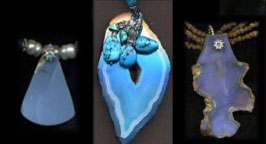 Spiral cut quartz crystal with powder blue faceted glass and bali silver; Saraphinite, freshwater pearls, bali and sterling silver—this sounds so luxurious and wildly creative as a piece of art and jewelry. These vivid descriptions belong to the jewelry of artist/designer Nora Brown of Nora Catherine Jewelry. Nora’s jewelry is one-of-a-kind art that should be displayed in a gallery, not just around somebody’s neck. In fact, that’s how I saw one of these stunning necklaces for the first time, around Nora’s neck at L.A. Fashion Week. She was volunteering, and seated me before a show. I couldn’t help but admire the lavish piece of art adorning her neck, and asked her where she got it. “It’s mine. I designed it,” she said.
Spiral cut quartz crystal with powder blue faceted glass and bali silver; Saraphinite, freshwater pearls, bali and sterling silver—this sounds so luxurious and wildly creative as a piece of art and jewelry. These vivid descriptions belong to the jewelry of artist/designer Nora Brown of Nora Catherine Jewelry. Nora’s jewelry is one-of-a-kind art that should be displayed in a gallery, not just around somebody’s neck. In fact, that’s how I saw one of these stunning necklaces for the first time, around Nora’s neck at L.A. Fashion Week. She was volunteering, and seated me before a show. I couldn’t help but admire the lavish piece of art adorning her neck, and asked her where she got it. “It’s mine. I designed it,” she said.
What is a talented jewelry designer/artist doing seating guests at a fashion show? As it turns out, several up-and-coming designers find their way volunteering at fashion events. They can take their pick from working the design suites, or seating guests at the runway shows. Their reasoning: volunteering gives them an opportunity to network and get a jump on the next season’s trends. In Nora’s case, she went to Los Angeles to get the experience at this level at Fashion Week. She actually had her jewelry in Portland Fashion Week, which is a much smaller event, and since Los Angeles is much bigger, making contacts and meeting people was imminent—a win-win situation.
I met so many people and just soaked it all in. I also gained the experience of working on an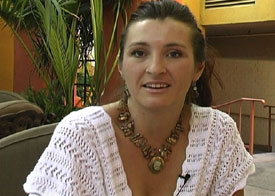 amazing fashion show. So I bought a ticket, hopped on a plane, came from Portland just to volunteer. The experience that I had at Fashion Week was nothing but good. I thoroughly enjoyed getting to work the shows, meeting people, just being around the clothing. Some of the pieces just put me in awe. Makes me want to work with some of these people some day. The whole experience was just amazing. I am so glad I came.
amazing fashion show. So I bought a ticket, hopped on a plane, came from Portland just to volunteer. The experience that I had at Fashion Week was nothing but good. I thoroughly enjoyed getting to work the shows, meeting people, just being around the clothing. Some of the pieces just put me in awe. Makes me want to work with some of these people some day. The whole experience was just amazing. I am so glad I came.
At a young age, Brown took clothing apart and figured out how to make patterns. She sewed a lot of her own clothes and wanted to put some beads on a collar.
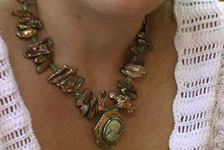 I had an old vintage garment, took the beads off and re-sewed them on, and just got really fascinated with the beads themselves. I’m self-taught so I looked at books, and other pieces of jewelry . . . things like the magazines, and I kind of went from there. I did a lot of stitching, like bead embroidering.
I had an old vintage garment, took the beads off and re-sewed them on, and just got really fascinated with the beads themselves. I’m self-taught so I looked at books, and other pieces of jewelry . . . things like the magazines, and I kind of went from there. I did a lot of stitching, like bead embroidering.
Being self-taught, was that difficult for you to get the hang of it?
Being self-taught is actually the way I learn the best in my music, in my designing. I’m pretty much a self-taught person.
So you’re also a musician?
I’m kind of a musician. I play the piano. My mom’s a music teacher—it runs in my family, but it’s just for fun .
Tell me about your jewelry. You’re wearing one of your pieces?
Yes, I am wearing one of my own pieces. My jewelry comes from the beads themselves. My inspiration comes from the stones. I love working with natural crystals, mineral formations, [and] fossils. I have a stonecutter that I’ll give a raw piece of stone and I’ll have him cut it exactly the way I want it. So each piece is most of the time a one-of-a-kind work of art.
What are the stones that you use?
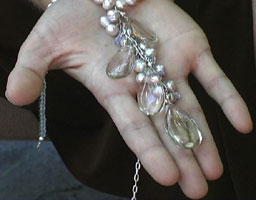 I work with quartz crystal, garnets, smoky quartz, some amber—a lot of semi-precious stones, whatever works really well with the pendants or the design. I don’t sketch anything in advance. It just kind of has to come to me. It’s kind of unplanned how they’re going to turn out.
I work with quartz crystal, garnets, smoky quartz, some amber—a lot of semi-precious stones, whatever works really well with the pendants or the design. I don’t sketch anything in advance. It just kind of has to come to me. It’s kind of unplanned how they’re going to turn out.
What’s your formula for selling? How do people know about your jewelry?
I sell my jewelry through a few local boutiques in Portland, Oregon. I used to own my own boutique, [but now] I am focusing on getting my jewelry in boutiques and local department stores. I do have a website, but I am focusing more on other boutiques.
So you have your jewelry in boutiques now. Which ones?
Dragonlily in Portland; and after I update my portfolio, I will be meeting with Saks in Portland. They are very interested in my work.
As a self-starter jewelry designer, was it difficult to set up your own boutique, and to get your jewelry into the boutiques they are in now?
I think that it was mostly difficult to really know the direction that I wanted to go. I met with a couple of boutiques, and finding the right atmosphere was the biggest key for me.
What’s the process of actually putting together a piece of jewelry, like the one you’re wearing now?
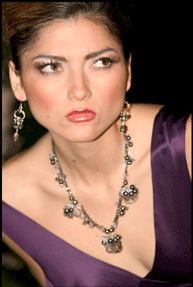 I’d go into the rock shop, and find a raw piece of stone or a finished pendant or a bead that I really love. It has to catch my attention. And then I’ll take that particular component and match it up with other beads. Sometimes it will take months or even years. It will sit there until the right thing comes along. Once I find the right components, I’ll just start playing. If it doesn’t look right—because I don’t sketch it out in advance—it just has to feel right. So I’ll just play. I’ll usually start with a pendant and work my way out to the back and then finish it off. It’s really just the feel, my mood, and what I’m going through at the time.
I’d go into the rock shop, and find a raw piece of stone or a finished pendant or a bead that I really love. It has to catch my attention. And then I’ll take that particular component and match it up with other beads. Sometimes it will take months or even years. It will sit there until the right thing comes along. Once I find the right components, I’ll just start playing. If it doesn’t look right—because I don’t sketch it out in advance—it just has to feel right. So I’ll just play. I’ll usually start with a pendant and work my way out to the back and then finish it off. It’s really just the feel, my mood, and what I’m going through at the time.
Where do you see yourself in 5 years?
I would love to hook up with clothing designers. I kind of got the fashion show bug in Portland. I’ve done a couple of fashion shows. I’d love to expand a little bit. Maybe go to L.A. and hook up with some great clothing designers, on top of doing the department stores.
Highest High
My highest high as a jewelry designer was when I walked into Saks Fifth Avenue, and they fell in love with the piece I was wearing and wanted me to come back and show my jewelry—that was totally unplanned. That was pretty big for me. So I am currently working on getting my portfolio re-shot. Most of my shots were done at Fashion Week, and they just don’t work well for a portfolio. That was a big one for me. And definitely coming to L.A. and experiencing this Fashion Week was really amazing, as well.
Lowest Low
Making the decision to close my boutique. It was a low, but it was also a high because it freed me up to just focus on being a designer. It was something I really enjoyed doing . . . and was something I really wanted to try, and it was a great experience. So I don’t really think of it as a total loss.
It probably helped you in the retail aspect of things.
It did. It put me right in there with the clients, and my possible clients. I learned who my clients are. Knowing your target market is a great thing to know. Just appreciating the boutique side of things, a lot of people coming in as a new designer don’t understand what it takes to run a boutique, so they can’t understand why a boutique needs to take certain percentage. But having worked both sides, I totally understand.
Nora Catherine Jewelry continues to expand with a variety of stones created with imagination and care. Brown’s select pieces are exquisite and will one day be valued at a much higher retail price. Currently, her pieces retail for as little as $50.00, and as much as $250.00. She says because she is new, she has to lower the benchmark to get her jewelry out there in the marketplace. But in the not too distant future, I believe that Nora Catherine Jewlery will be fetching couture prices.
To learn more about Nora Catherine Jewelry, visit Nora Brown’s website at www.noracatherine.com, or email her atnoracatherinejewelry@comcast.net.
Interview by Kaylene Peoples
Amanda Shi – Designing Outside the Box with Avita, the Eco-Friendly Clothing Line
| Amanda Shi – Designing Outside the Box with Eco-Friendly Avita Line
Avita is not only breaking out of conventions, but is also showing the fashion world that there are an infinite variety of ways of wearing cashmere and bamboo. In an attempt to help the environment, Amanda Shi of the Avita line did something outside of the box. She came up with a way to recycle cashmere and bamboo and create trendy wearable designs. Her inspiration for such a venture came when she purchased eco-friendly clothes from Whole Foods. She thought it would be a nice thing to expand on that idea and make eco-friendly clothes hip and trendy. Shi’s initial marketing plan was designed for women from the ages of 25 – 40, but she soon realized that her designs reached far beyond that demographic. Teenagers and their grandmothers wear her clothes. Having been featured in OCEAN, Justine, Item, Stylephile.com,Audrey, Apparel News, STAR Magazine; and worn by Andrea Bowen, Jennifer Love Hewitt, and Teri Hatcher, just to name a few; Amanda Shi has created a brand that has been embraced by the media, celebrities, and consumers. The inspired, purpose-driven designs not only aid in protecting the environment, but help to create a fashion statement. And Avita has forged a trend that is rapidly gaining momentum. With Avita, Amanda Shi has revolutionized fashion by providing cashmere and cashmere silk blends as everyday wear. She also introduced bamboo as a breathable, stylish fabric. Her current collection features an interesting pallet, which includes sand, topaz, mushroom, lavender, and black. And some of the most popular designs this season feature scooped backs, split open sleeves, Russian military buttons, and dresses with wraparound strips.
Why did you decide to recycle? What was your motivation to do it this way as opposed to the more traditional way? We live in an environment that we should start caring about, and I’m not even talking about global warming. That was awfully forward thinking of you. What is it about you that would make you go to these lengths to help save the environment? Because this is my business and I love clothes. I actually have very sensitive skin too. I even used to go to Whole Foods to buy clothes because they are environmentally friendly. Most of our pieces feel like butter on the skin when you put [them] on. The cashmere and bamboo really breathe. How did you decide to use bamboo? It’s really very interesting. We were looking for organic cotton and we couldn’t find How long has the Avita line been around? The Avita line has been around for 3 years. The bamboo line has been around for a year and a half. We were one of the first to start using bamboo. Where can people find your clothes? We have them at Fred Segal in Santa Monica, and we have a current store list across the country. You can find them on our website. If you type in the zip code, you will find the store closest to you. Do you do all the designing yourself? Yes, [but] we have a team of course, and I have a design assistant, and we work together on getting the marketing research done in getting the collection out every season. Tell me about your background. How did you get involved in designing?
Did you go to school for it? I studied fashion sketching, but I never went through a full program. I studied multimedia design, which is more focused on computer graphics, and motion graphics. Do you use any of that in your marketing? Yes, absolutely. Everything suddenly came into the picture. It’s very interesting, too, because I did business first and then I did multimedia design in school. I didn’t even know why I was doing it, and now I do. (Laughs.) Somebody had a bigger plan for you. Where are your parents from? We’re from Hong Kong, and the factory is in China. We moved the factory from Hong Kong to China in the early 90s because we wanted to expand the factory and spin our own yarn, but that was when I was in Canada. What do you charge for your designs? Our long sleeves range from $69-$89 wholesale, which is about $150-$200 retail. That’s unheard of, because that’s part cashmere, right? The fine gage silk and cashmere—we did it to give you a better figure, and we like to mix materials, something like a patch, to make it more funky or trendy. Who are your buyers? What is your demographic? Our marketing plan was for women between the ages of 25 – 40 in their career, because the idea was to have women wear it during the day and not have to change at night if they go out. At this point the demographic is pretty large: girls 15 and 16 years old, up to women in their 50s and 60s. It’s kind of ageless at this point. What is the actual process of making a blouse like the one you’re wearing?
There are a lot of things we do that cannot be done by computers. For example, some things are actually patched on. So it gives it a more contemporary look, instead of just knitted with a different color. Highest High (Laughs) When I see so many orders coming in, it’s proof of what we’ve done right. Even though it is a small business still, from the design, to the office, sales and distribution. Distribution is one of the biggest things. From sampling to production, everything has to be right to get that order shipped. Lowest Low There is a problem every day. It’s hard to keep the balance. Sometimes I get so frustrated. Because I am more of a creator, I am not completely on the logical side all the time. It’s really frustrating when something doesn’t work. I just keep telling myself if everyone could do this, then the Avita line would not be special. We really have solved a lot of problems since day one. It has been a great experience. That’s because you’re doing something that is so different. Yes, for example, the bamboo—a year and a half ago, it was so hard to sell. People liked to hear about it. The buyers thought it was interesting, but they kept on moving at the trade shows. It was really disappointing. Do you ever do any of the big shows, like the Fashion Weeks? We did the Mercedes Benz Suite Shows, a runway show with Audrey Magazine this year, and we’re trying to do something once a year. We don’t do too much because we’re trying to focus on sales and we’re trying to get the editorials so we can get the brand out. Because you’re doing something that is so different and you’re paving the way yourself, you have to be patient with yourself. It’s going to take longer than somebody doing something typical. We believe that we’re doing something good to influence this industry. Where do you see Avita line in 5 years?
Do you do all the season’s collections? Yes. We are trying to stay in the eco-friendly fields. So it makes it harder, but more specific. But it’s easier to do research. We want to go global. We want to get into Europe and go back to Asia. Currently everything is in the USA? Yes, we want to do a strong foundation here and have a brand. Within 5 years we will be everywhere. What advice would you give somebody in this industry who is trying to do something outside of the box? Just go with your gut feelings and don’t believe everybody else’s opinions because people like to comment—good and bad. Take the good and leave the bad, because if you start questioning yourself, that’s what’s going to stop you. So never give up. To learn more about Avita, visit the website at www.avitastyle.com. Interview by Kaylene Peoples |
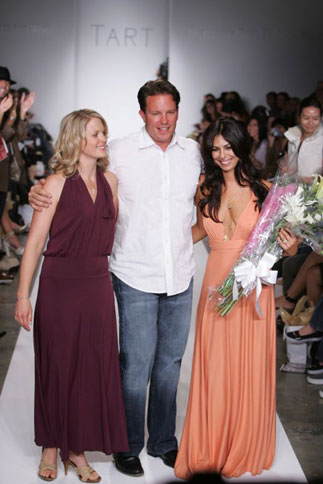
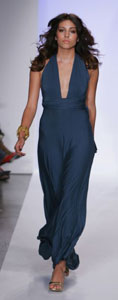



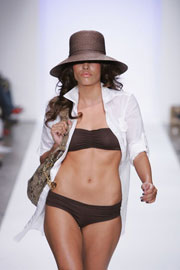

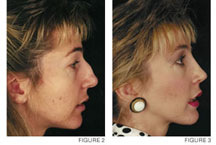
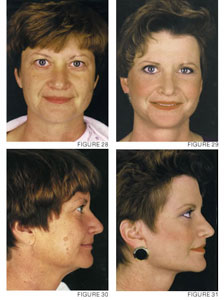
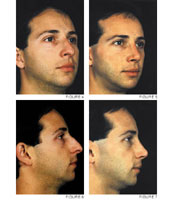
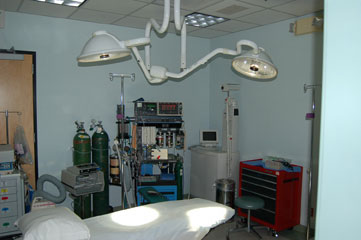
 You wouldn’t want a dermatologist to do rhinoplasty. Dermatologists have no background for it. Nor would you want an OBGYN to do a facelift. Make sure the person is trained in the specialty that he’s saying he’s operating. There’s no specialty in cosmetic surgery. It is performed by different doctors in different specialties. Cosmetic surgery itself is not a residency trained, recognized by the Medical Board of Medical Specialties.
You wouldn’t want a dermatologist to do rhinoplasty. Dermatologists have no background for it. Nor would you want an OBGYN to do a facelift. Make sure the person is trained in the specialty that he’s saying he’s operating. There’s no specialty in cosmetic surgery. It is performed by different doctors in different specialties. Cosmetic surgery itself is not a residency trained, recognized by the Medical Board of Medical Specialties. We have heard horror stories of people getting procedures like liposuction dying on the table, are those just freak accidents?
We have heard horror stories of people getting procedures like liposuction dying on the table, are those just freak accidents? You can take a bump off. You can narrow it. But if somebody, for example has thick skin, sometimes what you do doesn’t show as much. So, a realistic attitude is one of the most important aspects to judge a patient in this type of surgery.
You can take a bump off. You can narrow it. But if somebody, for example has thick skin, sometimes what you do doesn’t show as much. So, a realistic attitude is one of the most important aspects to judge a patient in this type of surgery.